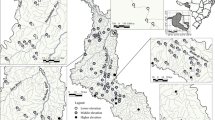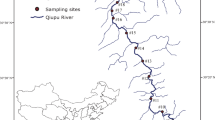Abstract
Two years of fish assemblage data from 28 sites in the Wabash River Indiana, were examined for relationships with environmental variables using a multivariate approach, correspondence analysis. Upstream sites had lower mean daily discharge and lower coefficient of variation of daily discharge when compared to downstream sites. Although the fish assemblage changed along this 230-km river distance gradient, patterns were in contrast to the patterns in streams with unaltered flow regimes. We compared functional variables of fish species (species traits that describe habitat, trophic, morphological, and tolerance characteristics) by examining the proportion of their occurrences along the hydrological variability gradient (upstream–downstream). The general pattern showed assemblages from hydrologically stable (upstream) sites had higher proportions of generalist species that tend to occur in small to medium streams, prefer fast current velocities, generally occur over rocky, gravel, and sand substrates, and have low silt tolerance. In addition, there was a pattern relating the hydrological/longitudinal regime and the overall morphology of species: species with higher caudal peduncle/caudal fin ratios and more fusiform body shapes occurred in higher proportion in upstream sites.
Similar content being viewed by others
References
Bain, M. B., J. T. Finn & H. E. Booke, 1988. Streamflow regulation and fish community structure. Ecology 69: 382- 392.
Barbour, M. T., J. Gerristen, B. D. Snyder & J. B. Stribling, 1999. Rapid Bioassessment Protocols for Use in Streams and Wadeable Rivers: Periphyton, Benthic Macroinvertebrates and Fish. Second Edition. EPA 841-B-99-002. U.S. Environmental Protection Agency, Washington, DC.
Gammon, J. R., 1994. The Wabash River Ecosystem. A Report for Eli Lilly and Co., Indianapolis, IN and PSI Energy, Plainfield, IN.
Gammon, J. R., 1998. The Wabash River Ecosystem. Indiana University Press, Bloomington.
Gammon, J. R. & T. P. Simon, 2000. Variation in a great river index of biotic integrity over a 20-year period. Hydrobiologia 422/423: 291-304.
Gorman, O. T. & J. R. Karr, 1978. Habitat structure and stream fish communities. Ecology 59: 507-515.
Gauch, H. G. Jr., 1982. Multivariate Analysis in Community Ecology. Cambridge University Press, Cambridge.
Herbert, M. E. & F. P. Gelwick, 2003. Spatial variation of headwater fish assemblages explained by hydrological variability and upstream effects of impoundment. Copeia 2003: 273-284.
Horwitz, R. J., 1978. Temporal variability patterns and the distributional patterns of stream fishes. Ecological Monographs 48: 307-321.
Hughes, R. M. & J. R. Gammon, 1987. Longitudinal changes in fish assemblages and water quality in the Willamette River, Oregon. Transactions of the American Fisheries Society 116: 196-209.
Karr, J. R., L. A. Toth & D. R. Dudley, 1985. Fish communities of Midwestern rivers: a history of degradation. Bio-Science 35: 90-95.
Leopold, L. B., 1997. Water, Rivers, and Creeks. University Science Books, Sausalito, CA.
Lyons, J., R. R. Piette & K. W. Niermeyer, 2001. Development, validation, and application of a fish-based index of biotic integrity for Wisconsin’s large warmwater rivers. Transactions of the American Fisheries Society 130: 1077-1094.
Matthews, W. J., 1985. Distribution of Midwestern fishes on multivariate environmental gradients, with emphasis on Notropis lutrensis. American Midland Naturalist 113: 225-237.
ORSANCO, 1990. Assessment of Nonpoint Source Pollution of the Ohio River. Toxic Substances Control Program, Ohio River Valley Water Sanitation Commission, Cincinnati, Ohio.
Peterson, J. T. & T. J. Kwak, 1999. Modeling the effects of land use and climate change on riverine smallmouth bass. Ecological Applications 9: 1391-1404.
Peterson, J. T. & C. F. Rabeni, 2001. The relation of fish assemblages to channel units in an Ozark stream. Transactions of the American Fisheries Society 130: 911-926.
Poff, L. N. & J. D. Allan, 1995. Functional organization of stream fish assemblages in relation to hydrological variability. Ecology 76: 606-627.
Poff, L. N., J. D. Allan, M. B. Bain, J. R. Karr, K. L. Prestegaard, B. D. Richter, R. E. Sparks & J. C. Stromberg, 1997. The natural flow regime. BioScience 47: 769-784.
Pringle, C. M., M. C. Freeman & B. J. Freeman, 2000. Regional effects of hydrologic alterations on riverine macrobiota in the New World: tropical-temperate comparisons. BioScience 50: 807-823.
Pusey, B. J., A. H. Arthington & M. G. Read, 1995. Species richness and spatial variation in fish assemblage structure in two rivers of the wet tropics of northern Queensland, Australia. Environmental Biology of Fishes 42: 181-199.
Pyron, M., C. C. Vaughn, M. R. Winston & J. Pigg, 1998. Fish assemblage structure from 20 years of collections in the Kiamichi River, Oklahoma. Southwestern Naturalist 43: 336-343.
Rankin, E. T., 1989. The Qualitative Habitat Evaluation Index (QHEI): Rationale, Methods, and Application. Ohio EPA, Division of Water Quality Planning and Assessment, Columbus, OH.
Resh, V. H., A. V. Brown, A. P. Covich, M. E. Gurtz, H. W. Li, G. W. Minshall, S. R. Reice, A. L. Sheldon, J. B. Wallace & R. C. Wissmar, 1988. The role of disturbance in stream ecology. Journal of the North American Benthological Society 7: 433-455.
Quinn, J. W. & T. J. Kwak, 2003. Fish assemblage changes in an Ozark River after impoundment: a long-term perspective. Transactions of the American Fisheries Society 132: 110- 119.
Schlosser, I. J., 1990. Environmental variation, life history attributes, and community structure in stream fishes: implications for environmental management and assessment. Environmental Management 14: 621-628.
Simon, T. P., 2003. Biological response signatures: toward the detection of cause-and-effect and diagnosis in environmental disturbance. In Simon, T. P. (ed.), Biological Response Signatures: Indicator Patterns Using Aquatic Communities. Lewis Press, Boca Raton, FL: 3-12.
Sparks, R. E., 1995. Need for ecosystem management of large rivers and their floodplains. BioScience 45: 168-182.
Stauffer, J. C. & R. C. Goldstein, 1997. Comparison of three qualitative habitat indices and their applicability to prairie streams. North American Journal of Fisheries Management 17: 348-361.
Taylor, C. M., M. R. Winston & W. J. Matthews, 1993. Fish species-environment and abundance relationships in a Great Plains river system. Ecography 16: 16-23.
Ter Braak, C. J. F. & I. C. Prentice, 1988. A theory of gradient analysis. Advances in Ecological Research 18: 271- 317.
Ter Braak, C. J. F. & P. Smilauer, 1998. CANOCO Reference Manual and User’s Guide to Canoco for Windows: Software for Canonical Communtiy Ordination (version 4). Microcomputer Power, Ithaca, NY.
Zorn, T. G., P. W. Seelbach & M. J. Wiley, 2002. Distributions of stream fishes and their relationship to stream size and hydrology in Michigan’s lower peninsula. Transactions of the American Fisheries Society 131: 70-85.
Author information
Authors and Affiliations
Corresponding author
Rights and permissions
About this article
Cite this article
Pyron, M., Lauer, T.E. Hydrological Variation and Fish Assemblage Structure in the Middle Wabash River. Hydrobiologia 525, 203–213 (2004). https://doi.org/10.1023/B:HYDR.0000038867.28271.45
Issue Date:
DOI: https://doi.org/10.1023/B:HYDR.0000038867.28271.45




